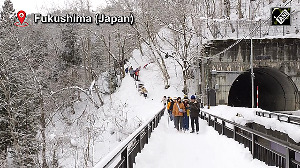The alpona (artwork) on the steep, winding road leading to Makaibari bears testimony to the visit of G20 delegates for the second tourism working group meeting in April last year.

The lush tea bushes, the delegates joining in for the moonlight plucking of Silver Tips Imperial first flush, a favourite of late Queen Elizabeth II, cut a picture of mystical magic.
But it’s not the Kurseong tea garden’s only shining moment — the last few years have been busy for the estate and its bungalow.
“It’s always full,” says Sanjay Das, Makaibari estate manager. Except for a few weeks in a year, when the Makaibari Bungalow is blocked for foreign buyers of tea from Japan and the UK, it's the high-end tourists who frequent the five-bedroom bungalow.
Adjacent to it, along another winding road is the Taj Chia Kutir.
On a visit, the buzz at the property, where two major firms have booked at least 50 of the 73 rooms for a conference, is palpable.
Set in the Makaibari estate, which houses the first tea factory going back to 1859, the Taj Chia Kutir overlooks acres and acres of rolling greens covered by virgin forests.
The project, in partnership with the Ambuja Neotia Group — lease holder of a part of the estate — opened in the middle of Covid in December 2020 and hasn’t looked back since.
It was between 2008 and 2010 that the Ambuja Neotia group picked up five properties in the eastern Himalayas – two have been built and three are in the design stage.
“The eastern Himalayas was never short of beauty.
"Yet, it didn’t attract luxury travellers who want to explore nature, but are also looking for comfort and convenience.
"That is now changing,” Harshvardhan Neotia, chairman, Ambuja Neotia group, says.
Jitendra Lote, general manager, Taj Chia Kutir, says, “Exploring the resort is to learn the journey of tea leaves from the estate to the cup.”
The implications for tea
The striking Chia Kutir creates an impression of grandeur. But step out of it and reality strikes — many of the gardens dotting the steep slopes along Pankhabari Road and elsewhere in Darjeeling hills that make some of the finest teas face an existential crisis.
Climate challenges and burgeoning costs make the struggle an important issue in the Lok Sabha poll on April 26.
Can tourism help Darjeeling tea?
Tourism has many benefits as long as it is sensitive to the environment and the local culture, says Rudra Chatterjee, managing director, Luxmi Tea.
“For Makaibari, the opportunity of connoisseurs to be able to trek the mountains that bear the tea, to pluck the leaves and visit the world’s oldest factory, to live the life of a planter in the Makaibari Bungalow — is to witness the mysticism of Makaibari that engenders appreciation and understanding of the craft of making Darjeeling tea,” he adds.
There are other rub-offs to the association with the Taj and the G-20.
About 22 km from Makaibari, another tea resort, the Mayfair in Siliguri, is making its presence felt.
The sprawling property is nestled in the New Chumta tea estate and there is a bit of it everywhere — the boards bearing the names of estate managers from 1866 hanging along the long corridors, chests forming the backdrop of a lounge, the green cover of bushes.
Dilip Agarwal, owner of New Chumta tea estate, says it’s a win-win for everyone.
“The government collects Rs 15 crore by way of goods and services tax (GST) against a very small amount for lease of land.
"Some of the workers have been absorbed in the hotel. And, it’s good for tea branding.”
Additional revenue stream for estates
The largest producer of Darjeeling tea, the Chamong group, has also thrown open three estates as resorts.
“Buyers wanted to stay at the estate. So initially, the idea was to maintain it as tea bungalows.
"But people’s expectations have gone up with the growing demand for tourism post-pandemic.
"So, we have refurbished bungalows in three resorts and positioned them at the top-end,” Ashok Lohia, chairman, Chamong group, says.
There are other examples of planters taking to tea tourism for additional revenues.
In 2020, Agarwal of New Chumta fame, bought the Sourenee tea estate and boutique resort in the verdant Mirik valley.
It has been upgraded since.
Anshuman Kanoria, who owns Goomtee estate, had planned to relaunch and repackage the bungalow as a premium destination, but it caught fire last year.
“The recent hail storm in Darjeeling hit the bushes so badly that it is unlikely we will be able to work on the bungalow this year,” he says.
Tea tourism policy
But the tea tourism policy under the Trinamool Congress (TMC) government is prompting many more planters to throw open the garden bungalows for tourism.
In 2019, the West Bengal government allowed tea gardens to use 15 per cent of total grant area up to a maximum of 150 acres for tea tourism and allied business activities.
Of this, 40 per cent can be used for construction.
The proposal to promote tourism in tea gardens in Jalpaiguri and Darjeeling districts was first introduced by the Left Front government in 2005.
But its scope has expanded under the current regime.












 © 2025
© 2025